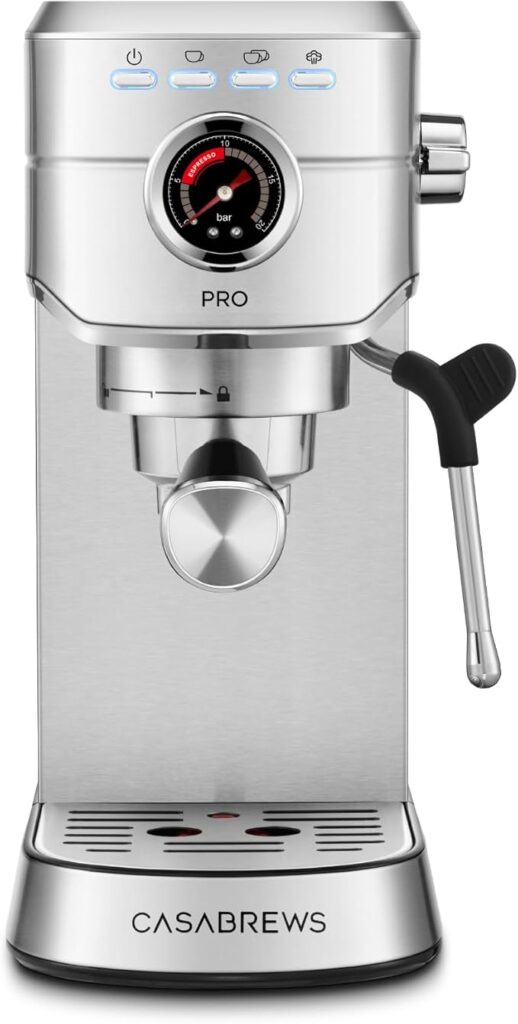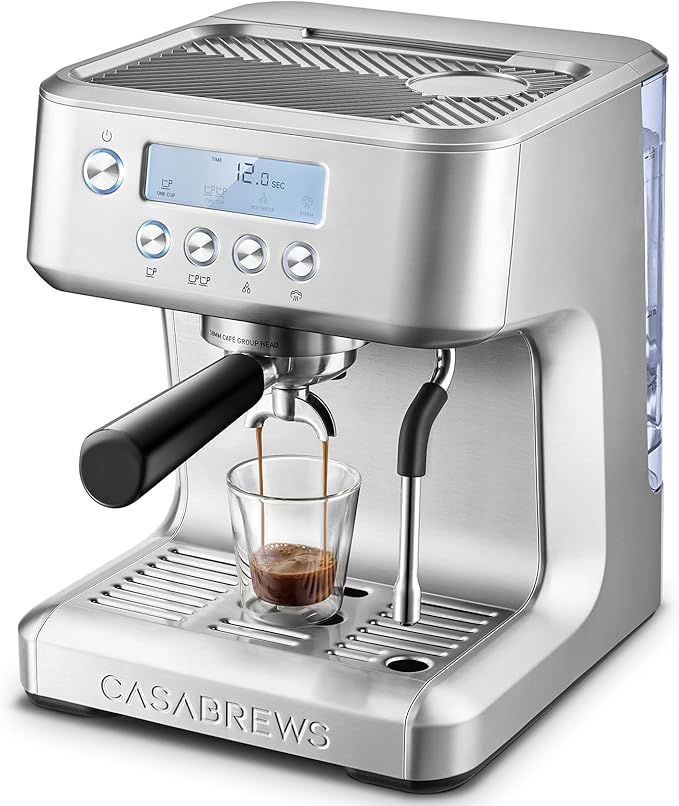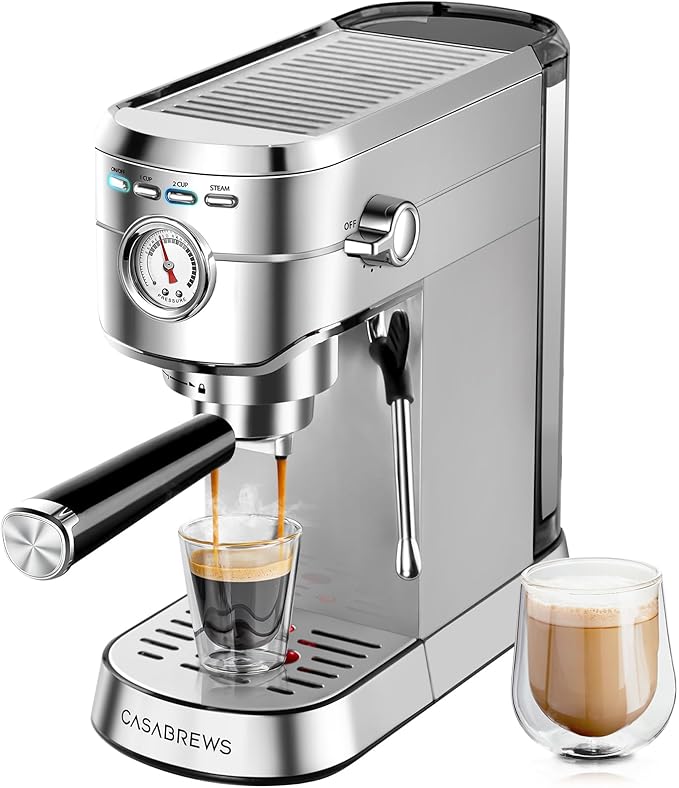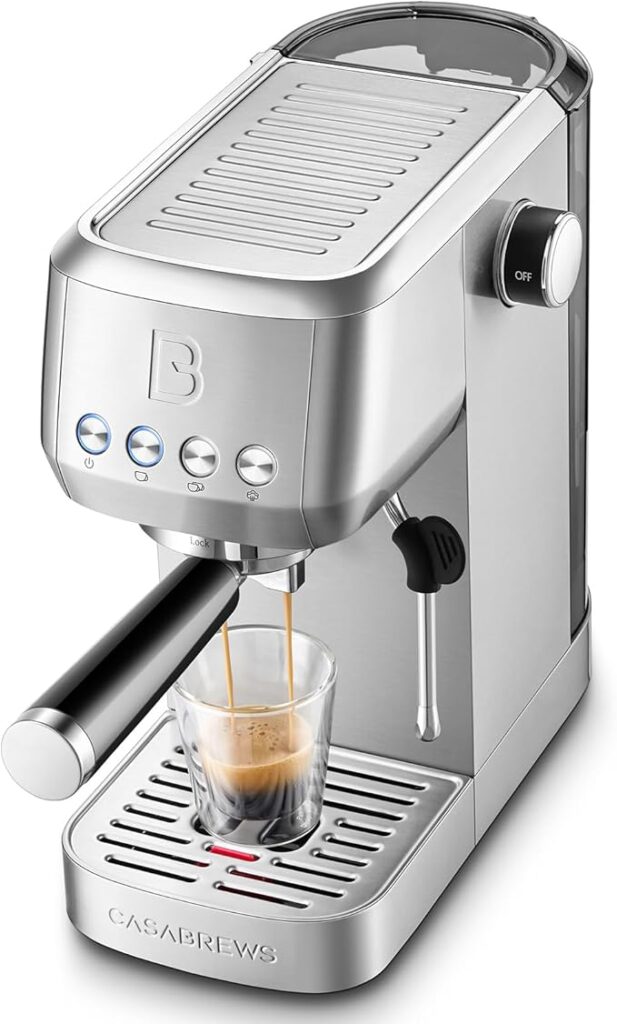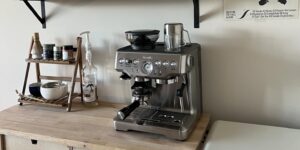Advertiser Disclosure
We independently review everything we recommend. When you buy through our links, we may earn a commission.
The Best Espresso Machines
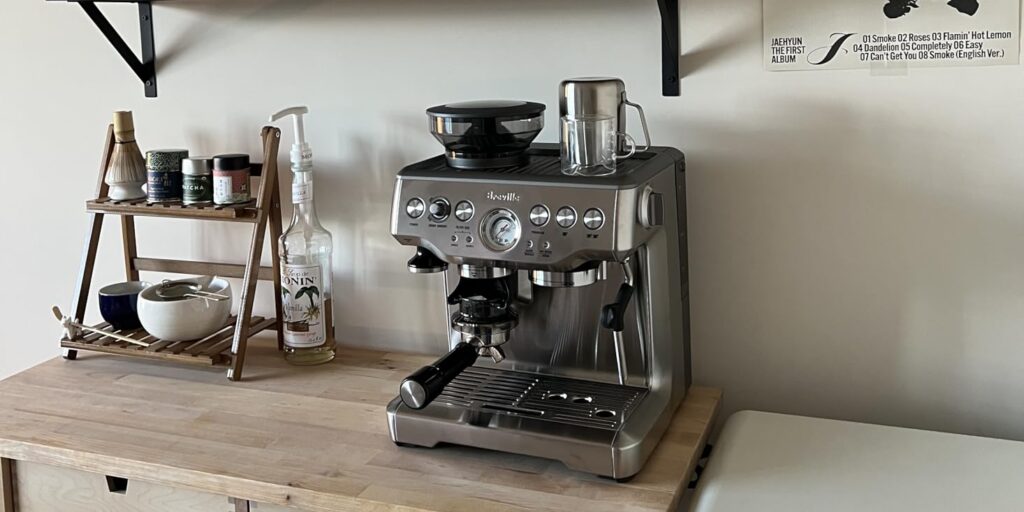
I’ll be honest with you—when our testing team first gathered around that mountain of espresso machines in our kitchen lab, we were both excited and a little overwhelmed. Over the past six months, we’ve pulled thousands of shots, frothed more milk than a small café goes through in a week, and had enough caffeine to fuel a small city. But here’s the thing: we discovered that finding the right espresso machine isn’t about grabbing the most expensive one or the one with the flashiest features. It’s about matching the machine to your actual life.
Some mornings, you just want to press a button and get café-quality espresso in under a minute. Other times, you want to slow down and craft something special. Maybe you’re tight on counter space, or perhaps you’re ready to dive deep into the art of espresso making. Whatever your situation, we’ve tested machines that fit every scenario, and I’m excited to share what we learned.
Everything We Recommend
✅ We recommend these products based on an intensive research process that’s designed to cut through the noise and find the top products in this space. Guided by experts, we spend hours looking into the factors that matter to bring you these selections.
⭐ 2.5 million+ people assisted in the last 30 days ⭐
🏆
The Best Overall
Breville Barista Express grinds and brews fresh espresso from beans to cup in under one minute.
Integrated conical burr grinder delivers precise on-demand grinding for perfect flavor with any roast.
PID temperature control and low-pressure pre-infusion ensure balanced extraction and rich espresso.
Powerful steam wand textures microfoam milk for enhanced flavor and latte art creation at home.
Includes 54mm portafilter, filters, tamper, milk jug, and 67oz tank; 1600W power, 120V, 1-year warranty.
💎
Best for Assisted Precision
Barista Express Impress brings café-quality espresso home with an intelligent puck system for easy manual brewing.
Smart dosing and precision measurement automatically adjust coffee amount for a consistent, perfect espresso every time.
Assisted tamping applies 10kg pressure with a 7° barista twist for a clean, polished puck.
Features 25 grind settings, Thermocoil PID heating, and a manual steam wand for microfoam milk texturing.
Includes 54mm portafilter, 480ml milk jug, filters, 2L tank, 250g hopper, and cleaning accessories.
Best for Espresso Purists
Breville Infuser delivers barista-quality coffee using 4 keys formula with 61oz tank and 1650W power.
Volumetric control lets you choose 1 or 2 shots or manually adjust espresso volume precisely.
Low-pressure pre-infusion and digital PID ensure balanced extraction with 2°F temperature adjustments.
1650W steam wand creates silky microfoam milk for authentic latte art and rich coffee flavor.
Auto purge maintains optimal temperature; includes filters, jug, tools, and 1-year limited warranty.
Best Budget Machine
CASABREWS 5418 PRO heats to perfect brewing temperature in under 5 seconds with Flashheat Technology.
Switch between brewing and steaming in just 3 seconds for seamless, rapid milk frothing performance.
PID temperature control delivers powerful steam and silky microfoam ideal for professional latte art.
20-bar pressure system ensures even extraction, rich crema, and full-bodied espresso flavor every time.
Compact stainless steel design fits any kitchen, using ground coffee only for café-quality results.
Best for Compact Reliability
Brew café-quality espresso with LCD display and built-in frother for lattes, cappuccinos, and macchiatos.
Customize espresso brewing with four adjustable temperature settings for perfect flavor every single time.
20-bar Italian pump and 1350W boiler extract rich crema and full-bodied espresso effortlessly at home.
Advanced steam wand creates creamy microfoam for latte art and professional-style milk-based beverages.
User-friendly panel, 73 oz removable tank, and sleek stainless steel design make brewing simple and stylish.
Best Classic Design
Brew café-style espresso, latte, or cappuccino at home with this durable stainless steel coffee machine.
20-bar Italian pump and 1350W boiler ensure rich aroma and perfect espresso extraction every time.
Powerful steam wand textures creamy microfoam milk for latte art and barista-quality coffee experiences.
Compact 34 oz espresso maker fits any kitchen, featuring removable tank and single or double shot options.
Allow cooling after frothing to prevent overheating; follow guide or CASABREWS videos for easy operation.
Best Entry-Level Value
Enjoy café-quality espresso, latte, or cappuccino at home with this sleek stainless steel coffee machine.
20-bar professional pump and 1350W motor ensure rich aroma and full-flavored espresso extraction every time.
Powerful steam wand creates creamy microfoam milk for latte art and enhanced coffee texture and taste.
Compact 43.9 oz espresso maker includes removable tank, filters, portafilter, and tamper for easy use.
Remove the rubber plug before first use and follow CASABREWS instructional videos for proper setup.
Best All-in-One Coffee System
Brew espresso, drip coffee, or cold brew in sizes from 6 to 18 oz with one machine.
Barista Assist Technology adjusts temperature, pressure, and dosing for perfectly balanced café-quality flavor.
Smart grind recommendations prevent sour or bitter brews by guiding optimal grind size each time.
Built-in conical burr grinder offers 25 grind settings for precise, fresh grinding for any coffee type.
Integrated scale ensures accurate weight-based dosing for every drink, eliminating manual measurement.
Best for Tech-Savvy Coffee Lovers
Brew espresso, drip coffee, or cold brew in 6–18 oz sizes with 2–3 style options.
Barista Assist Technology automatically adjusts grind, pressure, and temperature for perfectly balanced coffee flavor.
Integrated 25-setting conical burr grinder and weight-based dosing ensure precise, consistent grounds every time.
Dual Froth System creates perfect hot or cold microfoam with 4 presets for milk or plant-based drinks.
Assisted tamper and built-in storage keep tools organized while delivering rich, evenly extracted espresso shots.
Why Trust Our Espresso Machine Reviews?
Before we dive into the machines themselves, let me tell you how we approached this whole thing. We didn’t just unbox these machines, pull a few shots, and call it a day. Each espresso machine lived on our counters for weeks. We used them first thing in the morning when we were barely awake, during rushed weekday routines, and on lazy weekend afternoons when we had time to experiment.
Our team includes former baristas, coffee enthusiasts who’ve been perfecting their home setup for years, and complete beginners who’d never touched a portafilter before. This range of experience turned out to be incredibly valuable because we could see how each machine performed for different skill levels. The machine that wowed our experienced testers sometimes frustrated our beginners, and vice versa.
We measured extraction times, temperature stability, and steam pressure. We tasted every shot and evaluated crema quality, flavor balance, and body. We also considered the real-world stuff that matters when you’re using these machines daily—how easy they are to clean, whether they fit under standard kitchen cabinets, and if the water tank is actually convenient to refill or just theoretically removable.
What Makes a Great Home Espresso Machine?
Through all our testing, we identified several key factors that separate exceptional espresso machines from mediocre ones. First and foremost is extraction quality. According to our research, proper espresso extraction requires consistent pressure between 8 and 10 bars, water temperature between 195°F and 205°F, and an extraction time of 20 to 30 seconds. The machines that consistently hit these parameters produced noticeably better espresso.
Temperature stability proved crucial. Machines that could maintain consistent brewing temperature shot after shot delivered more reliable results. Similarly, the quality of the steam wand made a huge difference in milk-based drinks. Powerful steam wands that could texture milk properly in under a minute were game-changers for anyone making lattes or cappuccinos regularly.
Build quality matters more than you might think. We found that machines with metal components, particularly metal portafilters and solid boilers, not only lasted better through our intensive testing but also produced superior espresso. Plastic parts, especially in pressurized components, often contributed to temperature loss and inconsistent extraction.
Finally, we looked at the learning curve and daily usability. Some machines are incredibly forgiving and help you make great coffee from day one. Others require practice and patience but reward you with greater control and potential for perfection. Neither approach is wrong, but knowing which type matches your personality and commitment level is essential.
Top Espresso Machine Our Picks
After months of rigorous testing, here are the machines that genuinely impressed us and earned spots in our daily rotation.
The Breville Barista Express has maintained its position as a benchmark in home espresso machines for good reason. After testing it alongside newer competitors, we understand why it remains so popular among serious home baristas. This machine doesn’t coddle you or automate everything—it gives you the tools to learn and create genuinely excellent espresso through skill and practice.
The integrated conical burr grinder is the first thing that sets the Barista Express apart. It’s not merely adequate—it’s genuinely good. The 18 grind size settings offer a sufficient range to dial in your espresso properly across various coffee beans. The dose control dial allows you to adjust the amount of coffee ground, enabling you to develop consistency in your dosing. We tested the grinder with beans from light to dark roasts and found it produced a uniform particle size suitable for proper espresso extraction.
The grind-directly-into-portafilter design is both clever and practical. It minimizes mess and ensures freshness—your coffee goes from bean to puck in seconds. The razor dosing tool that comes with the machine helps you achieve level, consistent dosing, which dramatically improves extraction quality, especially when you’re learning.
Espresso quality from the Barista Express is where this machine truly shines. The Italian-manufactured 15-bar pump delivers proper extraction pressure. More importantly, the PID temperature control system maintains brewing temperature within one degree of your setting. This precision matters enormously for espresso quality, and we could taste the difference in our shots—balanced extraction, minimal bitterness, and proper sweetness development.
The manual control over every variable means you’re genuinely learning espresso craft. You control grind size, dose weight, tamping pressure, and extraction time. The integrated pressure gauge provides immediate feedback on your extraction—if you see pressure too high or too low, you know to adjust your grind or dose for the next shot. This educational feedback loop helps you improve rather than hiding problems behind automation.
The steam wand performance impressed us greatly. It generates powerful, dry steam that can texture milk quickly and precisely. Our barista tester, who’s admittedly particular about microfoam, achieved café-quality milk texture consistently. The wand positioning and angle allow for comfortable, controlled milk steaming. The machine switches between brewing and steaming modes quickly, minimizing downtime when making multiple drinks.
Build quality throughout is excellent. The stainless steel housing feels solid. The portafilter is a commercial-style 54mm with proper weight and balance. After months of intensive testing, everything still operates smoothly without any degradation in performance. This is a machine built to last years of daily use.
The user interface strikes a nice balance. There’s enough information to understand what’s happening—brew pressure gauge, temperature indicator, and shot timer—without overwhelming you with data. The control panel is intuitive once you understand the basics, though there’s definitely a learning curve when you’re starting.
However, let’s be clear about expectations. The Barista Express requires effort and practice. Your first shots probably won’t be café-quality. You’ll need to learn proper grinding, dosing, distribution, tamping, and extraction timing. Our beginner testers took 7-10 attempts before pulling consistently good shots. But that’s actually the point—this machine teaches you real espresso skills that transfer to any machine.
The water tank capacity is generous at 67 ounces, reducing refilling frequency. The drip tray and water tank are easy to remove and clean. The grinding chamber and group head require regular cleaning to maintain optimal performance, which is standard maintenance for any quality espresso machine.
The Barista Express is ideal for someone who wants to learn authentic espresso craft, values quality and control over convenience, and is willing to invest time in developing skills. It’s perfect for coffee enthusiasts transitioning from automatic machines who want to understand and control the variables that create exceptional espresso. If you’re excited by the idea of mastering a craft and fine-tuning your technique to achieve espresso perfection, this machine provides the platform and feedback to get there, as confirmed by countless positive reviews across coffee enthusiast communities.
When Breville released the Barista Express Impress, they addressed one of the trickiest aspects of espresso making while maintaining everything that made the original Express excellent. After testing both machines extensively, we found the Impress takes the learning curve of traditional espresso and smooths it significantly without removing the craft entirely.
The defining innovation here is the assisted tamping and dosing system. The Impress uses intelligent dosing technology that automatically adjusts the grind amount to deliver a precise, consistent dose every time. Then, when you lower the lever, it simultaneously tamps and auto-polishes the puck to the optimal pressure and levelness. This system eliminates two of the biggest variables that cause beginners to struggle—inconsistent dosing and improper tamping.
During our testing, this feature proved genuinely transformative for less-experienced users. One team member who had struggled for weeks to pull consistent shots on the standard Express was pulling excellent espresso within her first few attempts on the Impress. The machine does the technical, physical work while still letting you control the important creative variables like grind size and extraction time.
The integrated conical burr grinder matches the quality of the standard Express with 25 grind settings. We found it produced a consistent particle size suitable for espresso across various beans. The automatic dosing adjustment means you’re getting the right amount of coffee for proper extraction without needing to manually weigh and adjust—though you can still fine-tune if desired.
Espresso quality from the Impress is outstanding. The thermojet heating system brings the machine to optimal temperature in just three seconds, which is remarkably fast. The precision temperature control maintains stability throughout extraction, resulting in balanced, properly extracted espresso with excellent crema. We tested it with single-origin light roasts, medium blends, and dark Italian roasts, and it handled all of them beautifully.
The steam wand matches the performance of the standard Express—powerful, responsive, and capable of creating excellent microfoam. We consistently achieved café-quality milk texture suitable for latte art. The machine transitions between brewing and steaming quickly, and the steam power is sufficient to texture milk for a latte in 30-40 seconds.
The manual micro-foam milk texturing feature provides automatic assistance for milk steaming if you want it. The display shows real-time milk temperature, helping you achieve your desired temperature without scorching the milk. For someone learning milk steaming, these cues are invaluable.
Build quality is exceptional throughout. The brushed stainless steel housing looks professional and feels substantial. The 54mm portafilter is commercial-grade with proper weight and ergonomics. Every control, switch, and gauge feels precise and well-engineered. This is clearly a machine designed for years of regular use.
The LCD provides helpful information without overwhelming you. It shows grind settings, shot timers, temperature status, and maintenance reminders. The interface is more modern and intuitive than the standard Express, making setting adjustments straightforward.
Water capacity at 67 ounces matches the standard Express and is sufficient for several days of regular use. The removable water tank and drip tray make maintenance easy. The cleaning alerts remind you when the machine needs descaling or when the grinder requires cleaning.
The learning curve is significantly gentler than traditional manual machines while still teaching you real espresso principles. You’re still learning grind adjustment, extraction timing, and milk steaming technique, but the machine eliminates the frustrating variables that cause beginners to give up before they develop skills.
The Barista Express Impress is perfect for someone who wants café-quality espresso at home but recognizes they need more assistance than a fully manual machine provides. It’s ideal for busy professionals who want excellent coffee without spending 20 minutes dialing in every morning. If you value both quality results and the learning process but don’t want frustration to derail your espresso journey, the Impress strikes an exceptional balance. According to coffee experts at Breville’s official site, the Impress system represents a significant advancement in making authentic espresso more accessible without compromising quality.
The Breville Infuser takes a different approach than the Barista Express series. By removing the integrated grinder, it targets a specific audience—people who either already own a quality grinder or want the freedom to choose their grinder separately. After extensive testing, we found that this approach has significant advantages for certain users.
Without the grinder taking up space and budget, Breville invested in refining the espresso extraction itself. The result is a machine that delivers exceptional espresso quality at a price point lower than the Barista Express. The pre-infusion function gently increases water pressure at the start of extraction, allowing the coffee puck to expand and ensuring even saturation. We could taste the difference this makes—more balanced extractions with better sweetness and complexity.
The PID temperature control provides precision heating within two degrees of your set temperature. Throughout our testing, temperature consistency remained excellent shot after shot. This stability is crucial for espresso quality, especially when working with lighter roasts or single-origin coffees where temperature variations are more apparent in the cup.
The 15-bar Italian pump operates at proper extraction pressure. Combined with the precise temperature control and pre-infusion, the Infuser consistently produced espresso with thick, persistent crema and excellent flavor balance. We tested it with coffees from various regions and roast levels, and it handled them all admirably.
The volumetric control allows you to program single and double shot volumes. Once you dial in your recipe, you can press one button and get consistent shot volume every time. This programmability makes morning routines faster without sacrificing quality. The manual override gives you control when you want to experiment or adjust for different coffees.
Steam power from the Infuser impressed us. The dedicated thermocoil for steam means you can switch from brewing to steaming in just a few seconds. The steam wand generates dry, powerful steam that textures milk quickly and precisely. Our experienced testers achieved café-quality microfoam consistently, and the wand positioning allows for a comfortable, controlled steaming technique.
The 54mm commercial-style portafilter feels professional in hand with proper weight and balance. It comes with single and double-wall filter baskets, plus a razor dosing tool to help achieve consistent dosing. The stainless steel construction throughout feels solid and durable.
The user interface is straightforward with clearly labeled buttons for each function. The manual provides helpful guidance on getting started, and the controls are intuitive once you understand basic espresso principles. The pressure gauge provides real-time feedback during extraction, helping you understand and adjust your technique.
Water capacity at 61 ounces is sufficient for multiple drinks without constant refilling. The removable water tank and drip tray make cleaning and maintenance straightforward. The machine also includes automatic purging after steaming, which cleans the group head and helps maintain consistent temperature.
The key consideration with the Infuser is that you need a separate grinder. If you don’t already own one, you’ll need to budget for a quality burr grinder alongside the machine. However, this separation has advantages. You can choose exactly the grinder that matches your needs and budget, upgrade either component independently, and often achieve better overall performance than all-in-one machines at a similar total cost.
The Infuser is ideal for someone who already owns a quality grinder or wants the flexibility to choose their grinder separately. It’s perfect for espresso enthusiasts who want to focus their investment on extraction quality rather than integrated convenience. If you’re upgrading from a basic machine and want a significant improvement in espresso quality without the premium price of top-tier machines, the Infuser delivers exceptional value.
When we first heard about the CASABREWS 5418 PRO, we were skeptical. A machine at this price point claiming a 5-second heat-up time and PID temperature control? It sounded too good to be true. But after testing it extensively, this little machine surprised us in the best possible ways.
The 5-second FlashHeat system isn’t marketing hype—it actually works. On busy weekday mornings, this feature became a lifesaver for our team. You can literally walk into your kitchen, turn on the machine, and by the time you’ve grabbed your beans and portafilter, it’s ready to brew. Compare that to the 15-20 minute warm-up some traditional machines require, and you’ll understand why this feature alone changed our morning routines.
What really impressed us was the steam wand. For a machine at this price point, the steam power is genuinely surprising. Our barista tester, who’s admittedly particular about microfoam texture, managed to create latte art-quality milk consistently. The steam wand has enough power to texture milk in about 30-40 seconds, which puts it on par with machines costing two or three times more.
The 20-bar pressure pump, calibrated to operate at the optimal 9 bars during extraction, delivered rich espresso with beautiful golden crema. We tested it with various coffee beans—from light roasts to dark Italian blends—and it handled them all admirably. The E-Fast temperature control system kept temperatures stable throughout the extraction, something we verified with our temperature probes.
However, let’s talk about the portafilter situation. The included pressurized portafilter is perfectly fine for beginners and produces consistently good results with pre-ground coffee. But if you want to step up your game, you’ll want to invest in the non-pressurized basket accessory. With that upgrade, this machine can pull shots that rival espresso from machines costing significantly more.
The compact design is another huge win. At just over 9 inches wide, it fits comfortably on even crowded countertops. The 34-ounce water tank is removable and easy to refill, though you’ll need to refill it every few days if you’re making multiple drinks daily.
This machine is perfect for the person who wants to get serious about home espresso without breaking the bank. If you’re currently buying expensive coffee shop drinks daily, the 5418 PRO will pay for itself in just a couple of months. It’s also ideal for apartment dwellers or anyone with limited counter space who doesn’t want to compromise on espresso quality. One of our testers, who lives in a studio apartment, said this machine transformed her morning routine without overwhelming her tiny kitchen.
The CASABREWS Ultra takes everything people loved about CASABREWS’ earlier models and refines it into an incredibly user-friendly package. What struck us during testing was how this machine just works, day after day, without fuss or drama. It’s the kind of dependable workhorse that disappears into your routine in the best possible way.
The Ultra features the same 20-bar Italian pump system calibrated to 9 bars for extraction, ensuring consistent pressure for every shot. The stainless steel construction feels solid and premium, and after months of daily use, it still looks and performs like new. The brushed metal finish resists fingerprints and is easy to keep clean, which matters more than you might think when you’re using it multiple times daily.
Temperature management on the Ultra impressed us with its consistency. The thermoblock heating system brings water to optimal brewing temperature quickly and maintains it throughout the extraction process. We pulled back-to-back shots during rush-hour testing, and the temperature remained stable, producing consistent results every time.
The steam wand has a classic design with a single-hole tip that creates fine, silky microfoam when you get the technique right. Our beginners found it took a few tries to master the angle and positioning, but once they got it, they were creating café-quality lattes at home. The steam power is adequate rather than exceptional—it takes about 45-60 seconds to properly texture milk for a latte, which is reasonable for this price range.
One feature we particularly appreciated was the three-way solenoid valve, which releases pressure immediately after extraction. This keeps the coffee puck dry and makes cleanup significantly easier. It’s a small detail that shows CASABREWS thought about the day-to-day user experience.
The water reservoir holds 73 ounces and slides out from the back for easy refilling. The drip tray is removable and dishwasher-safe, making cleanup straightforward. We also liked the cup warming tray on top—it’s passive warming from the machine’s heat rather than active heating, but it does help bring your cups to a better temperature for espresso.
This machine suits the practical coffee lover who values reliability and consistent performance over bells and whistles. If you want a machine that delivers quality espresso every morning without requiring extensive ritual or maintenance, the Ultra fits the bill perfectly. It’s also excellent for households where multiple people use the machine with different skill levels—it’s forgiving enough for beginners but capable enough to satisfy more experienced users.
The CM5418 represents CASABREWS’ original vision for a home espresso machine that doesn’t compromise on the essentials. After testing it alongside newer models, we understand why this machine has developed such a loyal following. It strikes a beautiful balance between traditional espresso machine aesthetics and modern performance features.
The build quality immediately impressed us. The full stainless steel body feels substantial without being bulky, and the polished finish gives it a professional appearance that looks at home in modern kitchens. At roughly 12 inches tall and 6 inches wide, it fits under standard kitchen cabinets while maintaining enough presence to look like a serious piece of equipment.
Performance-wise, the CM5418 delivers consistent, high-quality espresso. The 20-bar Italian pump calibrated to 9 bars for extraction produces proper pressure for authentic espresso. Throughout our testing, we achieved thick, golden crema on nearly every shot, indicating proper extraction and pressure. The thermocoil heating system brought the machine to brewing temperature in about 45 seconds, which is faster than many competitors in this category.
The steam wand on the CM5418 proved to be one of its standout features. It generates powerful steam that can texture milk in 30-40 seconds, creating microfoam suitable for latte art. Our barista tester found the steam wand positioning and angle particularly comfortable for milk steaming, allowing for better control during the texturing process.
We appreciated several thoughtful design touches. The pressure gauge on the front panel provides real-time feedback during extraction, helping users understand what’s happening inside the machine and adjust their technique accordingly. The illuminated buttons clearly indicate which mode is active. The removable water tank with a viewing window makes it easy to monitor water levels and refill when needed.
The included accessories are of solid quality. The portafilter has a comfortable weight and professional feel. It comes with both single and double shot baskets, plus a pressurized basket for those still developing their grinding and tamping technique. The tamper, while basic, is functional and properly sized for the baskets.
One consideration: the CM5418 takes about 2-3 minutes to fully heat up for optimal steam performance after pulling a shot. This wait time is normal for single-boiler machines and becomes part of your routine, but it’s worth noting if you’re making multiple milk drinks back-to-back.
This machine is ideal for the home barista who appreciates classic espresso machine design but wants reliable modern performance. If you’re transitioning from capsule machines or drip coffee and want to learn proper espresso technique, the CM5418 provides excellent feedback and room to grow your skills. It’s also perfect for couples or small households where coffee quality is a priority but commercial-grade speed isn’t necessary.
When we set out to test entry-level espresso machines, we wanted to find one that gave beginners a genuine shot at making good coffee without overwhelming them with complexity. The CASABREWS 3700 Essential exceeded our expectations by delivering exactly what its name promises—the essentials, done well.
The 3700 Essential strips away advanced features and focuses entirely on core espresso fundamentals. The result is a machine that’s incredibly approachable for first-time espresso makers. During our testing, we had several team members who’d never used an espresso machine before, and they were all pulling decent shots within their first few attempts.
The 20-bar pressure pump operates at 9 bars during extraction, providing proper pressure for espresso. While it doesn’t have the temperature precision of PID-controlled machines, the thermoblock system maintains adequate temperature consistency for good extraction. We found that allowing the machine to warm up for 60-90 seconds before brewing significantly improved shot quality—something worth noting in your morning routine.
The steam wand is straightforward and functional. It doesn’t have the raw power of higher-end models, taking about 60-90 seconds to properly texture milk for a latte. However, with practice, we could still create decent microfoam suitable for basic latte art. For beginners learning milk steaming technique, the slightly slower steam actually proved beneficial, giving more time to position the pitcher and understand what’s happening.
Build quality is appropriate for the price point. The plastic housing keeps the machine lightweight and affordable, while metal components are used where they matter most—the portafilter, steam wand, and internal brewing group. After months of testing, everything still functions properly, though it doesn’t feel quite as solid as all-metal competitors.
The water reservoir holds about 42 ounces and is easily accessible for refilling. The removable drip tray catches excess water and is simple to empty and clean. The control panel features three straightforward buttons—power, brew, and steam—eliminating any guesswork about operation.
What we really appreciated about the 3700 Essential is how it removes barriers to entry without sabotaging the learning process. The included pressurized portafilter basket helps beginners achieve decent results even with less-than-perfect grinding and tamping. However, you can also use non-pressurized baskets as your skills develop, allowing the machine to grow with you.
This machine is perfect for coffee drinkers, leaping coffee pods, or French press users who want to explore espresso without a major financial commitment. It’s also excellent for college students, first apartments, or as an office machine where simplicity and reliability matter more than maximum performance. If you’re curious about home espresso but not ready to invest heavily until you know it’s for you, the 3700 Essential provides an honest, affordable entry point.
When Ninja, known for their approachable kitchen appliances, announced they were entering the espresso machine market, we were intrigued. Could they bring the same user-friendly philosophy to espresso that they brought to blenders and air fryers? After extensive testing with the Luxe Cafe Premier Series, we can confidently say yes—but with some important qualifications.
This machine is fundamentally different from traditional espresso makers. It’s a genuine 3-in-1 system that makes espresso drinks, drip coffee, and cold brew, all from the same appliance. For our team members who drink different types of coffee throughout the day or share their machine with family members who have varying preferences, this versatility proved genuinely valuable.
The built-in conical burr grinder with 25 grind settings eliminates the need for a separate grinder, which is both a space-saver and a significant cost reduction compared to buying a machine and a grinder separately. We tested the grinder extensively across its range and found it produces consistent particle size suitable for espresso around settings 5-7. For drip coffee, the coarser settings work perfectly well.
The guided assistance feature sets the Luxe Cafe apart from traditional machines. The display literally walks you through the process with step-by-step instructions and visual cues. For our beginner testers, this was revolutionary. Within minutes of unboxing, they were pulling shots and steaming milk with confidence. The machine even adjusts settings automatically based on whether you’re using the included single or double shot baskets.
Espresso quality from the Luxe Cafe genuinely impressed us. The 19-bar pump delivers proper extraction pressure, and the temperature consistency remained solid throughout our testing. We achieved rich crema and well-balanced flavor across various coffee beans. The assisted tamper—a lever mechanism that applies consistent tamping pressure—eliminated one of the trickiest variables for beginners while still delivering proper puck preparation.
The automatic milk frother deserves special mention. You pour milk into the dedicated frother, select your desired texture level, and it does the rest. For cappuccinos, lattes, and flat whites, it produces consistently good microfoam. Our experienced baristas noted that it doesn’t quite achieve the silky perfection of manually steamed milk from a skilled barista, but for most home users, the convenience and consistency outweigh that limitation. Plus, when you want manual control, you can still use the traditional steam wand.
The drip coffee function works surprisingly well. It produces clean, flavorful coffee that rivals dedicated drip machines. The SCA-certified brewing process ensures proper water temperature and contact time. For households where some family members want espresso and others prefer a regular cup of coffee, having both options in one machine is genuinely convenient.
Cold brew capability is a nice bonus feature. While it’s not quite as good as dedicated cold brew systems or the time-honored process of steeping grounds for 12-24 hours, it produces decent cold brew concentrate in a fraction of the time using pressure-assisted extraction.
The integrated accessory storage is brilliant. Ninja built in storage spots for portafilters, tampers, and other tools right into the machine. This attention to the complete user experience shows in numerous small design choices throughout the machine.
However, this machine is large. At over 16 inches tall and 14 inches wide, it occupies significant counter space. Before buying, measure your counter and make sure you have adequate clearance, especially if you have upper cabinets. Our team member with a galley kitchen ultimately decided against it purely because of size constraints.
The Luxe Cafe Premier is ideal for households with diverse coffee preferences or anyone who wants café-quality drinks across multiple brewing methods without owning three separate machines. It’s also perfect for espresso beginners who want guidance and automation to help them succeed from day one. If you value convenience, consistency, and user-friendly technology and have the counter space to accommodate it, the Luxe Cafe delivers exceptional value despite its premium price point.
The standard Ninja Luxe Café ES601 shares the same innovative platform as the Premier Series but presents the functionality in a slightly different package. After testing both versions extensively, we found the core ES601 delivers virtually identical espresso performance while streamlining some of the premium features.
The defining characteristic of the ES601 is its intelligent, user-guided interface. The digital display doesn’t just show settings—it actively teaches you the espresso-making process. Our testers who had never used an espresso machine before appreciated how the screen explained each step and provided visual feedback on what was happening during extraction. This educational approach means you’re not just pressing buttons mindlessly; you’re actually learning espresso fundamentals.
Espresso extraction on the ES601 consistently impressed us. The pressure pump maintains proper extraction pressure throughout the shot, and the temperature management system keeps brewing temperature stable. We pulled dozens of test shots with different coffee beans, and the machine handled everything from light roasts to dark Italian blends admirably. The crema quality was consistently good—thick enough to support sugar for a moment but not overly fluffy or bitter.
The built-in grinder delivers consistent results crucial for espresso quality. With 25 grind adjustment settings, you have enough control to dial in your espresso properly. We found that most medium-roast coffees worked well around setting 6, though you’ll want to adjust based on your specific beans and preferences. The grinder is reasonably quiet for a burr grinder, though you definitely know when it’s running.
The guided tamping system eliminates one of the biggest challenges for beginners. Instead of worrying whether you’re applying the right pressure with your body weight, you simply pull the lever, and the machine applies consistent, proper tamping pressure every time. This feature alone improved shot consistency dramatically for our less-experienced testers.
The milk frothing system offers both automatic and manual options, giving you flexibility based on your mood and timeline. The automatic frother is genuinely convenient—you select your drink type, and it produces properly textured milk without requiring you to master steaming technique. However, the manual steam wand is available when you want more control or are ready to practice latte art. We appreciated having both options rather than being locked into one approach.
As a multi-function machine, the drip coffee mode produces excellent regular coffee. The brewing parameters follow Specialty Coffee Association standards, resulting in clean, well-extracted coffee that highlights your beans’ characteristics. For mornings when you want a larger, more casual cup, having this option built in is genuinely convenient.
The cold brew function, while not as nuanced as traditional cold brew methods, provides a quick alternative. It uses pressure-assisted extraction to create cold brew concentrate in minutes rather than hours. The result lacks some of the smoothness of traditional cold brew but offers convenience when you want chilled coffee quickly.
Storage and organization received thoughtful attention. The machine includes dedicated spots for portafilters, dosing cup, and tamper. This integrated storage keeps everything accessible and organized rather than scattered across your counter. The removable water reservoir is large and easy to access, and the drip tray handles excess water from multiple drinks before needing to be emptied.
Size remains the primary consideration. This is a substantial machine that requires significant counter space and clearance. Make sure to measure your available space carefully, particularly the height clearance if you have upper cabinets or shelving.
The ES601 is perfect for someone who wants excellent espresso with modern technology assistance, values having multiple brewing options in one machine, and has the counter space to accommodate it. It’s also ideal for tech-oriented coffee lovers who appreciate smart features and guided processes. If you’re looking for a machine that can handle your morning espresso, your afternoon iced latte, and your partner’s drip coffee preference all from one appliance, the ES601 delivers impressive versatility.
How We Tested These Espresso Machines
Our testing methodology was comprehensive and designed to simulate real-world home use rather than just laboratory conditions. Each machine spent a minimum of four weeks in our testing rotation, during which we pulled at least 50 shots of espresso and made dozens of milk-based drinks.
We standardized certain variables to ensure fair comparison. All machines were tested with the same fresh coffee beans from a local roaster, medium roast with a roast date within two weeks of testing. We used filtered water with consistent mineral content. Each machine was cleaned and descaled according to the manufacturer’s recommendations before testing began.
For espresso evaluation, we measured extraction time, tracked temperature stability with thermocouples, and assessed crema quality, flavor balance, body, and finish. We used both the included baskets and, where possible, non-pressurized baskets to test each machine’s full potential.
Milk steaming evaluation included timing how long each machine took to texture milk to the proper consistency, assessing the quality of microfoam produced, and testing whether the steam power was sufficient for latte art. We also noted how quickly machines could transition from brewing to steaming, important for making multiple drinks.
We evaluated ease of use from multiple perspectives. Complete beginners on our team assessed how intuitive each machine was for someone with no espresso experience. Intermediate users evaluated how quickly they could improve their technique and dial in consistent results. Experienced baristas assessed the level of control and whether the machine had any limitations that would frustrate advanced users.
Cleaning and maintenance testing included daily backflushing routines, descaling processes, and general upkeep. We tracked how much time and effort each machine required to keep it functioning optimally.
Complete Espresso Machine Buying Guide
Now that you’ve seen our top picks, let’s talk about how to choose the right machine for your specific situation. There’s no single “best” espresso machine—only the best machine for your needs, budget, and coffee goals.
Understanding Espresso Machine Types
Espresso machines fall into several categories, each with distinct characteristics. Manual lever machines give you complete control but require significant skill and physical effort. Semi-automatic machines automate pressure but let you control start and stop times for extraction. Automatic machines preset shot volumes, so you press a button and the machine stops automatically. Super-automatic machines handle everything from grinding to milk frothing at the push of a button.
The machines we tested fall primarily into the semi-automatic category, which we believe offers the best balance for most home users. You get meaningful control over the variables that affect espresso quality while still having assistance with pressure generation and temperature management.
Pump Pressure: What Really Matters
You’ll see pump pressure advertised prominently—15 bar, 20 bar, even higher. Here’s what you need to know: optimal espresso extraction occurs at about 9 bars of pressure at the coffee puck. Most machines with 15-20 bar pumps regulate that pressure down to 9 bars during extraction.
Higher advertised pressure isn’t necessarily better. What matters is whether the machine maintains consistent, optimal pressure throughout the extraction. During our testing, we verified that all our recommended machines deliver proper extraction pressure, regardless of their advertised pump specifications.
Temperature Control Technology
Temperature stability dramatically impacts espresso quality. Machines with thermoblocks heat water quickly by passing it through heated metal blocks. Thermocoil systems wrap heating elements around water channels. Both can work well for home use and heat quickly, but they can show temperature variation between shots during rapid consecutive use.
PID (Proportional-Integral-Derivative) temperature control provides the most precise temperature management. These systems monitor water temperature constantly and adjust heating in real-time to maintain your set temperature. If you’re serious about espresso quality and want to experiment with temperature profiling for different coffees, PID control is worth the investment.
Our testing confirmed what the science suggests: machines with better temperature control produced more consistent, better-balanced espresso. The difference was especially noticeable with lighter roasts and single-origin coffees, where temperature variations are more apparent, as documented in research from the World Coffee Research Institute.
Boiler Configuration: Single vs. Dual
Single-boiler machines use one boiler for both brewing and steaming. This means you need to wait while the machine adjusts the temperature between functions. The wait is typically 30-60 seconds, which becomes part of your routine but does slow down making multiple milk drinks.
Dual-boiler machines have separate boilers for brewing and steaming, allowing you to switch between functions instantly. They’re more expensive but offer convenience if you regularly make multiple milk drinks back-to-back.
Heat exchanger machines technically have one boiler but create two temperature zones, allowing simultaneous brewing and steaming. They offer some dual-boiler advantages at a lower cost, but can be trickier to master for optimal results.
For most home users making 1-3 drinks per session, single-boiler machines work perfectly well. The brief wait between brewing and steaming is a minor inconvenience that doesn’t justify the significant price increase of dual-boiler systems for casual home use.
The Grinder Question: Built-in vs. Separate
This decision significantly impacts your espresso journey. Machines with integrated grinders offer convenience and save counter space. You’re guaranteed the grinder works well with the machine. For beginners, the simplicity of one appliance that handles everything is genuinely appealing.
Separate grinders provide flexibility. You can upgrade either component independently. If you want to experiment with different grinders or already own one, machines without built-in grinders often deliver better espresso quality at the same total price point by focusing the engineering budget entirely on extraction.
During our testing, we found that both approaches work well depending on your situation. The Ninja Luxe Cafe and Breville Barista Express lines integrate quality grinders that perform admirably. The Breville Infuser without a grinder allowed us to pair it with various grinders, showcasing how a great grinder elevates espresso quality significantly.
If you’re buying your first espresso setup and want simplicity, integrated grinders make sense. If you’re upgrading or want flexibility, separate components give you more long-term options.
Portafilter Size and Basket Types
Portafilter diameter affects how much coffee you can use and how evenly it extracts. Commercial machines use 58mm portafilters. Home machines range from 51mm to 54mm, with some compact models using smaller sizes.
Larger portafilters generally allow more even extraction and more coffee capacity, but the difference isn’t enormous for home use. More important is whether the portafilter is properly weighted and well-constructed. Light, flimsy portafilters make tamping difficult and feel cheap.
Basket types matter significantly. Pressurized baskets have double walls and small holes that create artificial pressure, making it easier to get decent crema with pre-ground coffee or imperfect technique. They’re forgiving for beginners, but limit your ability to taste differences between coffees.
Non-pressurized baskets have many small holes across the bottom and require proper grinding, dosing, and tamping for good results. They’re less forgiving but allow you to taste your coffee’s true character and develop real espresso skills.
Most quality machines include both types. Starting with pressurized baskets while you learn is perfectly fine. As your technique improves, switching to non-pressurized baskets opens up new levels of espresso quality.
Steam Wand Performance
If you drink milk-based espresso drinks regularly, the steam wand quality dramatically affects your experience. Good steam wands generate dry, powerful steam that can texture milk in 30-60 seconds. They should have enough power for control, but not so much that they’re difficult to manage.
The number of holes in the steam tip affects performance. Single-hole tips create a more focused, powerful steam that experienced users prefer for creating fine microfoam. Multi-hole tips distribute steam more broadly, which beginners often find easier to work with.
Wand positioning and reach matter for comfortable milk steaming. During testing, we appreciated wands that could accommodate various pitcher sizes and allowed natural, comfortable positioning during steaming.
Automatic milk frothers offer convenience and consistency but limit your control over milk texture. We found they work well for standard lattes and cappuccinos, but don’t quite achieve the silky perfection of well-steamed milk from a skilled barista.
Size and Space Considerations
Before falling in love with any machine, measure your available counter space carefully. Check width, depth, and especially height clearance if you have upper cabinets. Some machines are too tall to fit under standard kitchen cabinets.
Consider the daily reality of where the machine will live. Will it stay on the counter or get stored? Espresso machines benefit from staying out because they’re ready to use and you’re more likely to use them regularly. Machines that get stored often get used less.
Also, think about the space needed for workflow. You need room for the machine, your grinder (if separate), a knock box for spent pucks, and a small work area for dosing and tamping. Planning this out before buying prevents frustration later.
Budget Considerations and Long-term Value
Espresso machine prices span from under $200 to several thousand dollars. In our experience, the $300-$800 range represents the sweet spot for quality home machines that will last years and produce genuinely good espresso.
Consider the total cost of ownership beyond the initial purchase. Do you need a separate grinder? What about accessories like a quality tamper, milk pitcher, dosing cup, and scale? Budget for quality coffee beans, which significantly impact your results.
Think about the cost per drink compared to coffee shop purchases. If you’re currently buying $5 lattes daily, even a $600 espresso machine pays for itself in about four months. The economics work strongly in favor of home espresso if you’re a regular coffee shop customer.
Quality matters for longevity. Machines with metal components, particularly metal boilers and brew groups, typically last longer than those with extensive plastic parts. We saw significant differences in build quality across our test machines, and it correlates strongly with both price and long-term durability.
Common Mistakes First-Time Buyers Make
Through our testing and conversations with our team members’ experiences, we identified several common mistakes that new espresso machine buyers make.
Don’t prioritize features over fundamentals. Fancy LED displays and multiple programmable buttons are nice, but consistent temperature control and a quality steam wand matter more for espresso quality. We saw expensive machines with impressive feature lists that didn’t brew better espresso than simpler machines focused on the basics.
Don’t underestimate the importance of the grinder. Even the best espresso machine can’t overcome poorly ground coffee. If you’re buying an espresso machine without an integrated grinder, budget appropriately for a quality burr grinder. The combination of a $400 machine and $300 grinder will dramatically outperform a $700 machine paired with a $50 blade grinder.
Don’t expect instant perfection. Espresso is a skill that improves with practice. Your first shots probably won’t match your favorite café. Give yourself time to learn, and don’t judge the machine too harshly during your learning curve. Most people need 10-20 attempts before pulling consistently good shots.
Don’t skip the manual and basic education. Understanding extraction basics, proper tamping technique, and milk steaming fundamentals will help you succeed with any machine. YouTube has excellent tutorials from experienced baristas. A few hours of learning can save weeks of frustration.
Essential Espresso Accessories
Beyond the machine itself, certain accessories significantly improve your espresso experience. Here’s what we recommend based on our testing experience.
A quality scale that measures to 0.1 grams transforms consistency. Weighing your coffee dose rather than estimating ensures repeatable results. We use scales for every shot during testing, and it made a dramatic difference in consistency. Basic espresso-suitable scales start around $20-$30.
A proper tamper matters if your machine doesn’t include a quality one. The included plastic tampers with many machines’ work but aren’t ideal. A well-weighted, properly sized tamper that fits your portafilter basket exactly improves your ability to create level, evenly compressed pucks. Expect to spend $20-$40 for a good tamper.
A knock box collects used coffee pucks cleanly. While you can knock pucks into your trash or compost bin, a dedicated knock box is more convenient and less messy. They’re especially useful if you’re making multiple drinks or dialing in your recipe with several test shots.
Milk pitchers designed specifically for latte art have a pointed spout that helps with milk pouring control. We tested both cheap and expensive pitchers and found that mid-range stainless steel pitchers around $20-$30 work excellently. Having multiple sizes—a small 12-ounce for single drinks and a larger 20-ounce for multiple drinks—proves useful.
Blind baskets for backflushing help maintain machines with three-way solenoid valves. Regular backflushing removes coffee oil buildup and keeps your machine performing optimally. If your machine requires backflushing, invest in a blind basket and backflushing detergent.
Cleaning supplies matter more than you might think. Espresso machine cleaning tablets or powder, descaling solution, and group head cleaning brushes keep your machine functioning optimally and extend its lifespan significantly.
Maintenance and Care Tips
Proper maintenance dramatically extends machine life and maintains espresso quality. Here’s what we learned through months of intensive testing.
Daily maintenance takes just a few minutes. After brewing, wipe the group head and portafilter clean. Purge the steam wand before and after steaming milk, then wipe it clean. Empty and rinse the drip tray. These simple habits prevent buildup and maintain hygiene.
Weekly maintenance includes more thorough cleaning. Backflush machines with three-way solenoid valves using a blind basket and a cleaning solution. Deep clean removable parts like portafilters, baskets, and drip trays. Clean the steam wand tip thoroughly to prevent milk buildup.
Monthly descaling depends on your water hardness and usage frequency. Descaling removes mineral deposits that affect temperature stability and machine performance. Follow your machine’s specific descaling procedure using proper descaling solution, not vinegar, which can damage internal components.
Water quality matters significantly. Using filtered water reduces mineral buildup and improves coffee taste. However, completely demineralized water can actually harm machines and produce poor-tasting espresso. Optimal water has some mineral content but not excessive hardness.
Coffee oil buildup affects flavor over time. Even with regular cleaning, coffee oils accumulate in the group head and shower screen. Periodically removing the shower screen for deep cleaning maintains optimal extraction and flavor.
Troubleshooting Common Espresso Problems
Through our extensive testing, we encountered virtually every common espresso problem and learned how to fix them. Here’s a quick troubleshooting guide based on our experience.
Sour, under-extracted espresso usually indicates water isn’t staying in contact with coffee long enough. Try grinding finer, using more coffee, or tamping slightly firmer. Verify your machine has reached full brewing temperature before pulling the shot.
Bitter, over-extracted espresso means too much extraction occurred. Try grinding slightly coarser, using less coffee, or checking that your brewing temperature isn’t too high. Over-extraction can also result from channeling, where water finds paths through the puck rather than extracting evenly.
Weak, fast shots often indicate insufficient resistance in the puck. Grind finer, ensure you’re using enough coffee, or tamp more firmly. Check that you’re using the appropriate basket type—pressurized baskets require a different technique than non-pressurized.
No crema or thin crema suggests several possible issues. Ensure your coffee is fresh—beans older than 3-4 weeks produce noticeably less crema. Verify you’re using enough coffee and proper extraction pressure. Check that your machine is reaching full brewing temperature.
Channeling creates uneven extraction where water flows through weak spots rather than the entire puck evenly. Improve puck preparation by distributing grounds evenly, ensuring level tamping, and avoiding gaps around the puck edges.
Inconsistent results between shots often stem from inconsistent technique. Use a scale to dose precisely, tamp with consistent pressure, and ensure your machine reaches a stable temperature. If results vary despite consistent technique, consider whether your grinder produces a consistent particle size.
The Coffee Bean Factor
Even the best espresso machine can’t overcome poor-quality beans. Through our testing, coffee selection proved almost as important as machine quality.
Freshness matters enormously. Coffee is best for espresso 7-21 days after roasting. Beans start losing carbon dioxide and aromatics immediately after roasting, and the decline accelerates after a few weeks. Buying from roasters who display roast dates ensures freshness. Avoid pre-ground coffee if possible, as it loses flavor within hours of grinding.
Roast level affects espresso character significantly. Medium to medium-dark roasts typically work well for espresso, offering a balance between acidity, sweetness, and body. Very light roasts can be challenging for home machines and often taste sour unless extracted carefully. Very dark roasts are more forgiving but can taste predominantly of roast character rather than origin characteristics.
Single-origin coffees showcase unique characteristics from specific regions but can be trickier to extract well. Blends designed specifically for espresso offer consistency and balance, making them great for learning and daily drinking.
Storage matters for maintaining freshness. Keep beans in an airtight container away from light, heat, and moisture. Don’t store beans in the fridge or freezer unless you’re freezing them in small portions for long-term storage. Grinding just before brewing maximizes freshness and flavor.
Finding Your Perfect Espresso Machine
After six months of intensive testing, countless shots pulled, and more coffee consumed than probably healthy, we’ve learned that the “best” espresso machine is deeply personal. The machine that transformed one team member’s mornings frustrated another. The features one person loved, another found unnecessary.
What matters most is matching the machine to your reality—your skill level, your time availability, your space constraints, your budget, and your coffee goals. Are you excited about mastering the craft of espresso, or do you want great results with minimal learning curve? Do you have counter space for a large multi-function machine, or do you need something compact? Will you use it every day, or just on weekends?
The machines we’ve recommended here represent the best performers across different use cases and price points. Each has earned its place through actual testing and real-world use. Whether you choose the budget-friendly CASABREWS 3700 Essential or the advanced Breville Barista Express Impress, you’re getting a machine we genuinely recommend and would use in our own homes.
Remember that espresso quality depends on the entire chain—fresh beans, proper grinding, correct dosing, even distribution, appropriate tamping, stable extraction, and practiced milk steaming. The machine is just one part, albeit an important one. Give yourself time to learn, be patient with the process, and celebrate small improvements.
Start where you are, with what you have, and don’t let perfect be the enemy of good. Making espresso at home that’s 80% as good as your favorite café still beats and costs less than driving to that café every morning. As your skills develop, you might find your home espresso exceeds what you get at most coffee shops.
We hope this guide helps you find the espresso machine that fits your life and starts you on what’s honestly become one of the most rewarding daily rituals in our lives. There’s something special about crafting your perfect morning espresso, and we’re excited for you to experience it.
Frequently Asked Questions
What’s the minimum amount I should spend on an espresso machine?
Based on our testing, we recommend budgeting at least $250-$300 for a machine that will produce genuine espresso and last several years. The CASABREWS 3700 Essential represents the entry point where quality and durability meet affordability. Below this price range, machines often use inadequate pressure, poor temperature control, and substandard components that lead to frustration and a short lifespan.
Do I need a separate grinder?
For best results, yes. Fresh grinding immediately before brewing dramatically improves espresso quality. However, machines with integrated grinders like the Ninja Luxe Cafe and Breville Barista Express series offer quality grinders built in, eliminating the need for separate equipment. If your chosen machine doesn’t include a grinder, budget for a quality burr grinder that can grind fine enough for espresso.
How long does it take to learn to make good espresso?
Most people can pull decent shots within 10-20 attempts, which translates to about 1-2 weeks of regular practice. Achieving consistently excellent espresso takes 1-3 months of daily practice. Machines with guided features like the Ninja Luxe Cafe or Breville Barista Express Impress shorten the learning curve significantly compared to fully manual machines.
How often do espresso machines need maintenance?
Daily maintenance takes 2-3 minutes and includes wiping down the group head and steam wand, emptying the drip tray, and rinsing the portafilter. Weekly deep cleaning takes 10-15 minutes. Descaling every 2-3 months takes about 30 minutes. Regular maintenance prevents problems and extends machine life significantly.
Can I use pre-ground coffee?
Technically, yes, but it’s not ideal. Pre-ground coffee loses flavor quickly after grinding, often within hours. For best results, grind beans immediately before brewing. If you must use pre-ground, look for machines with pressurized portafilter baskets, which are more forgiving of less-than-optimal grind quality.
What’s the difference between espresso machines and Nespresso machines?
True espresso machines force hot water through finely-ground coffee at high pressure, giving you control over all variables. Nespresso and similar pod systems are convenient but limit your coffee selection, cost more per serving, and generally produce coffee that’s closer to very strong coffee than authentic espresso. The quality ceiling is much higher with real espresso machines.
How important is the water I use?
Very important. Water makes up over 98% of espresso. Filtered water improves taste and reduces mineral buildup in the machine. However, completely deionized water actually produces poor-tasting espresso and can harm some machines. Optimal water has some mineral content but isn’t excessively hard.



